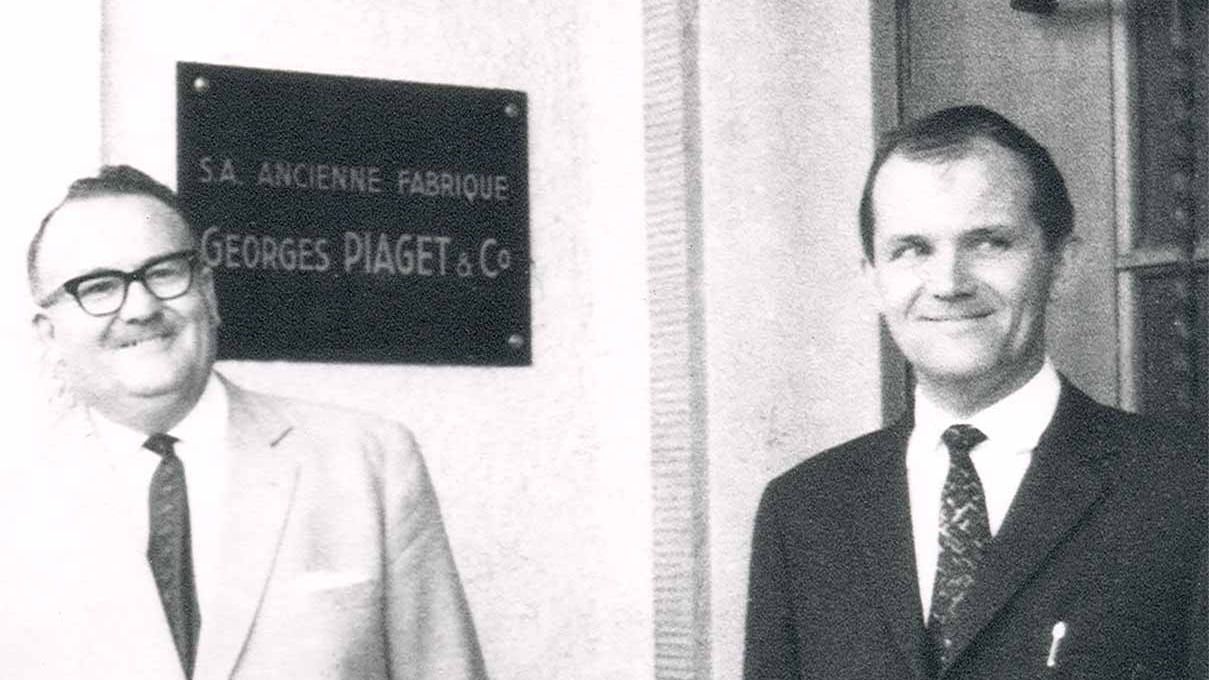ADVERTISEMENT

Piaget was a family-owned manufacture until 1988, led only by Piaget family members. Valentin Piaget (right, in the image above) was the grandson of founder Georges-Edouard Piaget, and he played a key role in the company's development beginning in 1945. While his brother Gerald was CEO and focused on the business, Valentin worked more on the products themselves, developing some of the thinnest calibers ever made, which helped make Piaget the paragon of elegance it is today. He was deeply involved in the creation of the calibers 9P and 12P, which were respectively ultra-slim manually-wound and automatic movements, with the 12P holding the title of the world's slimmest automatic movement for decades.
Launched in 1957, the caliber 9P boasts a thickness of just 2mm, making it one of the thinnest hand-wound wristwatch movement ever made.
When Gerald and Valentin Piaget took over for their father in 1945, the two brothers were facing a great challenge: make the Piaget name stand out on its own. It was not that the watchmaking skills of the family and their employees were contested in any way, but until the 1940s the Piaget brand had not been registered or promoted. In fact, most Piaget watches did not bear the Piaget name on the dial, and the delivery of finished movements to other watchmakers prolonged Piaget's anonymity in the eyes of the public.
But the two brothers had a trump card – a brand new manufacturing facility in La Cote-aux-Fées where they could focus almost exclusively on making slim movements. This effort paid off, and in 1957 the 9P caliber was unveiled. Its 2mm thickness truly allowed Piaget to present itself as the "specialist of the slimmest watches in the world." The reduced thickness was a very practical feat, since it allowed the production of slimmer watches. This also allowed Piaget to fit the more imposing hard-stone dials (usually with a 0.7mm thickness) that would become a signature for Piaget heading into the 1960s and 70s.
ADVERTISEMENT
The 12P ingeniously relied on a 24k micro-rotor for its automatic winding.
Yet, Valentin and his team did not stop at the manually-wound 9P, as they were also aiming at offering the slimmest automatic caliber ever made. And they eventually succeeded after two more years of research, which culminated in the caliber 12P. At 2.3mm, this movement was barely thicker than the 9P, but cannot be considered as a mere evolution of its predecessor. The whole construction had to be re-started from scratch in order to accommodate for the micro-rotor, an ingenious system previously adopted by Universal Genève and Gruen. The 12P was presented at the Basel fair in 1960 and stunned the watchmaking world.
Creating a 2.3 mm-thin self-winding caliber had previously seemed a pipedream. The entire research team in La Cote-aux-Fées can take pride in having written one of the finest chapters in watchmaking history, and in having worked in the same spirit that drove the pioneers.
– Journal de Genève, 1960The 12P was even more revolutionary than the 9P, and Piaget's advertising kept on highlighting its incredible dimensions, again placing the brand as the specialist of ultra-thin watches. It would actually take more than a decade for another movement to break the the 2.3mm limit, with the Jean Lassalle caliber 1200 reaching a mesmerizing 1.2mm thickness (at the cost of prohibitive fragility). And at no point would Piaget abandon its quest of slimness, developing the thinnest quartz movement in 1976 with the caliber 7P, and more recently the 3.65mm Altiplano reference 900P (in this case, that measurement is for the entire watch, not just a movement).
The 3.65mm Altiplano 900P can be seen as the modern continuation of Valentin Piaget's work and accomplishments.
The fact that the name Piaget is now immediately associated with thin and elegant watches has nothing to do with luck; on the contrary, it was the hard work of Valentin Piaget and his brother Gerald (and later his nephew Yves as well) that made Piaget what it is today. There is no doubt that today the manufacture has lost a man to whom it owes its legacy.



































Top Discussions
Talking Watches With Ronnie Fieg, Founder Of Kith
Photo Report The Sights, Scene, Watches, And Style Of Watches & Wonders 2024
Patek Philippe Standardizes Water Resistance To 30 Meters Across Its Lineup